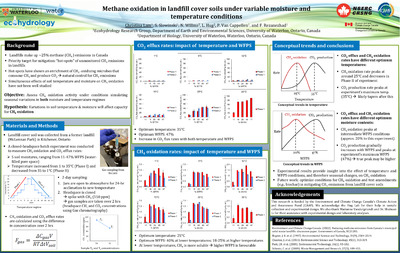| dc.contributor.author | Lam, Christina | |
| dc.contributor.author | Slowinski, Stephanie | |
| dc.contributor.author | Willms, N | |
| dc.contributor.author | Hug, L | |
| dc.contributor.author | Van Cappellen, Philippe | |
| dc.contributor.author | Rezanezhad, Fereidoun | |
| dc.date.accessioned | 2023-06-15 19:22:35 (GMT) | |
| dc.date.available | 2023-06-15 19:22:35 (GMT) | |
| dc.date.issued | 2023-05-15 | |
| dc.identifier.uri | http://hdl.handle.net/10012/19544 | |
| dc.description.abstract | Landfills are one of the largest anthropogenic sources of methane (CH4), comprising over 20% of
Canada’s CH4 emissions. Hot-spots of CH4 emissions in landfill cover soils have shown an enrichment of
microbes that consume CH4 and produce carbon dioxide (CO2) through CH4 oxidation, which can act as
a natural solution to reduce CH4 emissions. CH4 oxidation is affected by soil moisture and temperature,
although their simultaneous effects on CH4 oxidation rates have not been well-studied. Here, we
conducted a closed-headspace batch experiment with cover soil from a former landfill in Waterloo,
Ontario, to measure CH4 oxidation and CO2 efflux rates associated with variations in soil moisture and
temperature simultaneously. The soil samples were prepared under 5 soil moisture contents (% WFPS;
water-filled pore space), ranging from 11 to 47% WFPS, and incubated following a regime whereby
temperatures increased from 1 to 35°C (Phase I) then decreased from 35 to 1°C (Phase II). Every 2 days,
the temperature was adjusted to the next value for a 24-hour acclimation period while open to the
atmosphere, then the headspace was closed and spiked with CH4 (150 ppm). Headspace CH4 and CO2
concentrations were measured over 2 hours to calculate apparent CH4 oxidation and CO2 efflux rates.
The maximum CO2 efflux rate was observed at the maximal WFPS and temperature conditions of this
experiment (91.5 nmol h-1 g dry wt.-1 at 47% WFPS and 35°C). In contrast, the maximum CH4 oxidation
rates were observed at intermediate WFPS and temperature conditions (1.86 nmol h-1 g dry wt.-1 at
25% WFPS and 25°C). These experimental results provide insight into favourable WFPS and temperature
conditions for CH4 oxidation, and therefore into how seasonal changes in WFPS and temperature could
impact CH4 oxidation. | en |
| dc.description.sponsorship | This research was undertaken thanks, in part, with support from the Global Water Futures Program funded by the Canada First Research Excellence Fund (CFREF) | en |
| dc.language.iso | en | en |
| dc.publisher | University of Waterloo | en |
| dc.relation.ispartofseries | Global Water Futures; | |
| dc.subject | GWF AOSM 2023 | en |
| dc.title | Landfill cover soils: variable moisture and temperature effects on methane oxidation | en |
| dc.type | Conference Poster | en |
| dcterms.bibliographicCitation | Lam, C; Slowinski, S; Willms, N; Hug, L; Van Cappellen, P & Rezanezhad, F. (2023). Methane oxidation in landfill cover soils under variable moisture and temperature conditions. Global Water Futures (GWF) Annual Open Science Meeting Conference. University of Waterloo. | en |
| uws.contributor.affiliation1 | Faculty of Science | en |
| uws.contributor.affiliation2 | Earth and Environmental Sciences | en |
| uws.typeOfResource | Text | en |
| uws.peerReviewStatus | Unreviewed | en |
| uws.scholarLevel | Graduate | en |

